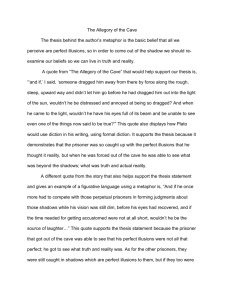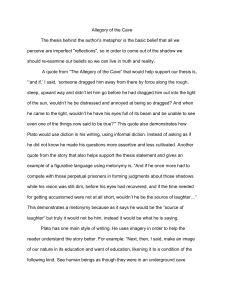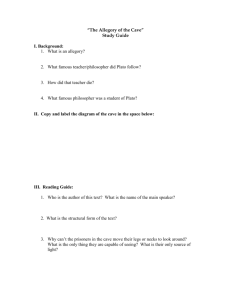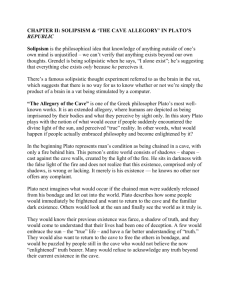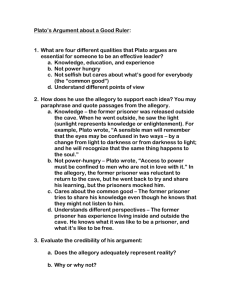Ideas on How to Write a Good Introduction and
advertisement
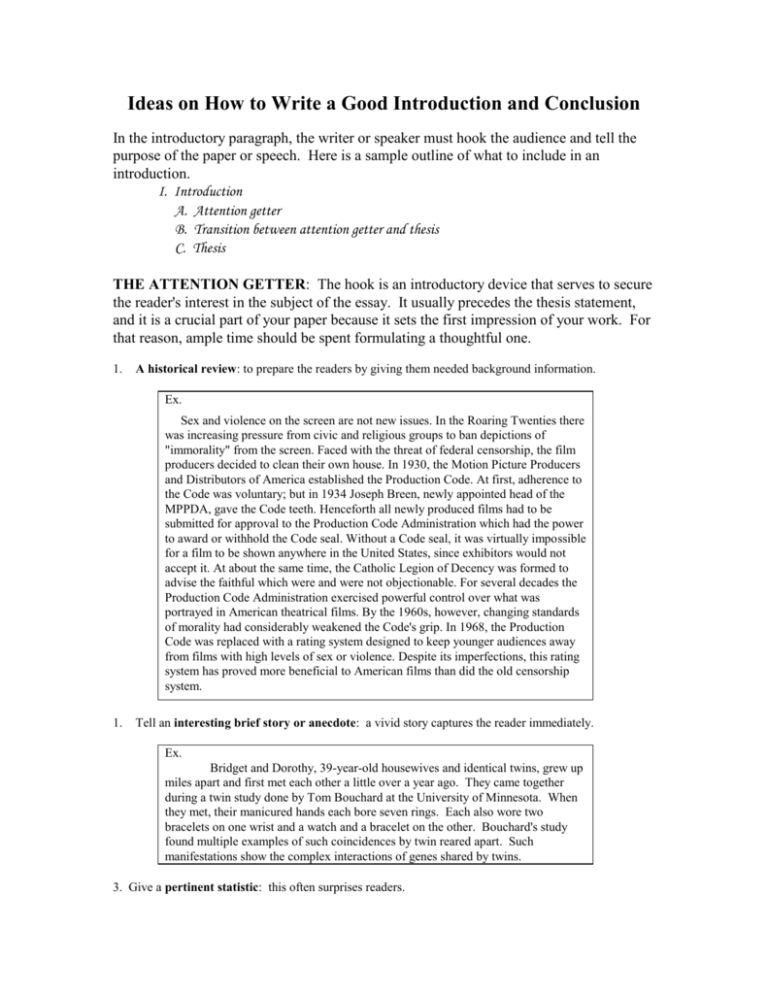
Ideas on How to Write a Good Introduction and Conclusion In the introductory paragraph, the writer or speaker must hook the audience and tell the purpose of the paper or speech. Here is a sample outline of what to include in an introduction. I. Introduction A. Attention getter B. Transition between attention getter and thesis C. Thesis THE ATTENTION GETTER: The hook is an introductory device that serves to secure the reader's interest in the subject of the essay. It usually precedes the thesis statement, and it is a crucial part of your paper because it sets the first impression of your work. For that reason, ample time should be spent formulating a thoughtful one. 1. A historical review: to prepare the readers by giving them needed background information. Ex. Sex and violence on the screen are not new issues. In the Roaring Twenties there was increasing pressure from civic and religious groups to ban depictions of "immorality" from the screen. Faced with the threat of federal censorship, the film producers decided to clean their own house. In 1930, the Motion Picture Producers and Distributors of America established the Production Code. At first, adherence to the Code was voluntary; but in 1934 Joseph Breen, newly appointed head of the MPPDA, gave the Code teeth. Henceforth all newly produced films had to be submitted for approval to the Production Code Administration which had the power to award or withhold the Code seal. Without a Code seal, it was virtually impossible for a film to be shown anywhere in the United States, since exhibitors would not accept it. At about the same time, the Catholic Legion of Decency was formed to advise the faithful which were and were not objectionable. For several decades the Production Code Administration exercised powerful control over what was portrayed in American theatrical films. By the 1960s, however, changing standards of morality had considerably weakened the Code's grip. In 1968, the Production Code was replaced with a rating system designed to keep younger audiences away from films with high levels of sex or violence. Despite its imperfections, this rating system has proved more beneficial to American films than did the old censorship system. 1. Tell an interesting brief story or anecdote: a vivid story captures the reader immediately. Ex. Bridget and Dorothy, 39-year-old housewives and identical twins, grew up miles apart and first met each other a little over a year ago. They came together during a twin study done by Tom Bouchard at the University of Minnesota. When they met, their manicured hands each bore seven rings. Each also wore two bracelets on one wrist and a watch and a bracelet on the other. Bouchard's study found multiple examples of such coincidences by twin reared apart. Such manifestations show the complex interactions of genes shared by twins. 3. Give a pertinent statistic: this often surprises readers. Ex. Old men, old women--almost 20 million of them fill the world today. They constitute 10 percent of the total population, and the percentage rises yearly. Some of them, like conspirators, walk all bent over, as if hiding some precious secret, filled with self-protection. The body seems to gather itself around those vital parts, folding shoulders, arms, and hips like a fading rose. With such fragility of the body, what happens in the mind often goes unseen. Alzheimer's Disease impacts more and more people each year, and more funding must be allotted to find a cure. 4. Ask a provocative question: allows the reader to become part of the speech or essay. Ex. Today, what respectable person would call a candidate for the highest office in the land a carbuncle-faced old drunkard and mutton-headed cucumber? Such charges were commonplace in the presidential contests of the nineteenth century. This past election, simpler terms like "immoral" and "dishonest" filled the media. As campaign elections spiral out of control, reform must follow to ensure ethical and just presidential races. 5. Use a quote: using a quote provides well-phrased, interesting remarks for a reader to consider. Ex. "Man did not weave the web of life; he is merely a strand in it. Whatever he does to the web, he does to himself," said Chief Seattle in "How Can You Buy or Sell the Sky?" The metaphor of a web relates well with the overall concept of a community. In Burke's introduction of The Pinball Effect, he writes, "We all live on the great, dynamic web of change. It links us to one another and, in some ways, to everything in the past." America was once a place where people visited their neighbors, sat on front porches, and helped out each other at harvest, but today's culture is drastically different. Neighbors are no longer entwined in this interdependent web. With the disenfranchisement of America, schools must fill the gap of creating community in cities and towns. 6. Go from the general to the specific: this is a good way of taking the reader from the familiar to the less familiar. Ex. Though we prefer to think of man as basically good and reluctant to do evil, such is not the case. Many of the crimes inflicted on humankind can be dismissed as being committed by the degenerates of society at the prompting of the abnormal mind. But what of the perfectly "normal" man or woman who commits inhumane acts simply because he or she has been ordered to do so? It cannot be denied that such acts have occurred, either in everyday life or in war-time situations. Unfortunately, even normal, well-adjusted people can become cruel, inhumane, and destructive if placed in the hands of unscrupulous authority. Such was the case in the village of My Lai, Vietnam, on March 16, 1968, when a platoon of American soldiers commanded by Lt. William Calley massacred more than 100 civilians, including women and children. 7. Make a useful analogy Ex. Imagine, if you will, human beings imprisoned in a cave, with their necks shackled to prevent the turn of their heads. Far above them is a light into which a few brave souls venture. Those who escape the cave experience a painful journey upward. Once they grow accustomed to the light, they have a painful journey back. Yet, they must go back to the cave in hopes that more people will be influenced to find the light. This is how Plato envisioned the idea of democracy in his "Allegory to a Cave" in Book VII of Republic. The point of this allegory can be transferred to the concept of democracy in education. The leaders, or those who have been to the light, must encourage others on this path. Granted, the path will be fraught with difficulty, but once they have experienced democracy, they will fight to preserve it and further it. 8. Define a term used throughout the essay. Ex. Marriage, as defined by the 1600's Canon Book of Law, "is a legal, sacred, and unyielding status entered into by a man and woman." Teenagers may contemplate marriage for a variety of reasons, and most of them are misguided. Before they plead their lifelong devotion to their one and only; however, teenagers should secure the counsel of an impartial party before seriously considering this life option. 9. Create a literary device, such as a metaphor, simile, personification, etc Ex. Lurking in the shadows of the American dream is the overwhelming desire to decide what is and is not right, the desire to have personal opinion become public policy, and the desire to protect the masses from obscene and inappropriate materials. While these desires may seem noble, they work against the First Amendment guarantee of free speech. Nat Hentoff addresses contemporary First Amendment issues in his book Free Speech for Me--But Not for Thee, including the impact of censorship on high school classrooms, freedom of expression in college, symbolic free speech, and offensive hate speech. What to avoid in introductory paragraphs: Don't be too obvious. Avoid statements such as: "In this paper…" or "This assignment says…" Don't apologize. Avoid saying, "I'm not sure…" or "This paper will attempt…" Don't use cliches or overworn expressions. Avoid: "A penny saved is a penny earned..." etc… Don't ask questions that can be answered. ------------------------------------------------------------------------------------------------------------------------------- THE CLINCHER: Concluding paragraphs are also very important. They serve to make a logical ending to your discussion. An ending this is too abrupt leaves your reader suddenly cut off. On the other hand, you can't just tack on a paragraph and call it quits. An ending that flows gracefully and sensibly reinforces your ideas and enhances a strong essay. This is a common format for a closing (will vary based on type of paper): 1. Find new words to communicate your restated thesis 2. Summarize main points in a brief and concise way 3. Use references to the hook BUT avoid using the same device in the conclusion III. Conclusion A. Restatement of the thesis B. Summarize main points C. Clincher (examples at LEO’s strategies for writing a conclusion: http://leo.stcloudstate.edu/acadwrite/conclude.html) 1. Answer the question so what? 2. Show how your ideas work together 3. Challenge the reader 4. Look to the future Ex. Imagine, if you will, human beings imprisoned in a cave, with their necks shackled to prevent the turn of their heads. Far above them is a light into which a few brave souls venture. Those who escape the cave experience a painful journey upward. Once they grow accustomed to the light, they have a painful journey back. Yet, they must go back to the cave in hopes that more people will be influenced to find the light. This is how Plato envisioned the idea of democracy in his "Allegory to a Cave" in Book VII of Republic. The point of this allegory can be transferred to the concept of democracy in education. The leaders, or those who have been to the light, must encourage others on this path. Granted, the path will be fraught with difficulty, but once they have experienced democracy, they will fight to preserve it and further it. AND LATER… From the Bill of Rights to the ERA, Americans have fought to ensure equality, justice, and happiness for all people. The democratic ideals for society have trickled into every institution, including public education. Schools must strive for reforms that promote social responsibility and individual rights for all students. Plato said, "Democracy is a charming form of government, full of variety and disorder, and dispensing a sort of equality to equals and unequals alike." Only when school leaders promote the ideals of democracy will they succeed in achieving Plato's goal of helping everyone out of the cave. Ex. "Laws which disable women from full participation in the political, business, and economic arenas are often characterized as 'protective' and beneficial…The pedestal upon which women have been placed has all too often upon closer inspection, been revealed as a cage." (Blount, 1998, 139) Since the medieval system of European feudalism, women have endured their place atop a very fragile pedestal--a pedestal that seemed too high from which to jump. As time progressed and women became more and more educated, that pedestal seemed more and more surmountable. Instead of being caged upon it or plunging to destruction, our foresisters took a running leap to soar. Throughout many types of cultures and a series of centuries, women have fought for their status as educators and administrators. No place has this struggle for equity been more apparent, more disheartening, and more victorious than in the public school systems on the United States. In Destined to Rule the Schools: Women and the Superintendency, 18731995, author Jackie M. Blount researched women's accession into the ranks of school leaders. AND LATER… Jackie Blount's Destined to Rule: Women and the Superintendency, 18731995 provides a unique historical perspective into the history of women in educational leadership roles. With or without the titles associated with leadership, women have contributed greatly to the education of America over the past 400 years, and their contributions will be even more essential with the change of the millennium. As women make great strides in the quest for status in educational leadership, more and more of them can be seen sitting in comfortable, swivel chairs that face desks with the name plate of superintendent. And it is this type of chair seems to have replaced that uncomfortable and sometimes dangerous pedestal. What to avoid in the conclusion: Don't introduce a new idea or go off track. Don't reword your introduction. The introduction and conclusion should not be interchangeable. Don't announce what you have done. Avoid saying, "This proves that…" or "I have tried to show you that…" Don't make absolute claims. Avoid saying, "This proves that…" Always qualify your message. Avoid logical fallacies. Conclusions are vulnerable to errors in reasoning. Don't apologize or speak tentatively. Avoid saying, "Even though I'm not an expert…"

